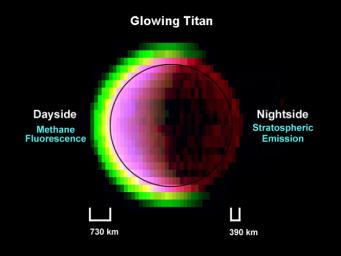
|
Glowing Titan
- Click the image above for a larger view
- Full-Res JPEG (720 x 540) (30.8 kB)
- Full-Res TIFF (720 x 540) (335.3 kB)
Caption:
The glow of Titan's extensive atmosphere shines in false colors in this view of Saturn's gas-enshrouded moon acquired by the Cassini spacecraft visual and infrared mapping spectrometer during the July 2, 2004, flyby. This image is a combination of near-infrared colors, each of which probes different phenomena in the moon.
From its vantage point over Titan's terminator, both the dayside and nightside of the crescent moon are seen, with the sunlit side on the left. In this false color rendition, green light is the fluorescent emission of methane gas powered by sunlight, at a wavelength of 3.3 microns. This is some five times the wavelength visible to the human eye. The glow extends over 700 kilometers (435 miles) above the surface, revealing the unusual thickness of the moon's atmosphere, which nearly doubles Titan's volume compared to the volume of the solid sphere, indicated by the solid line. On the nightside (right side), the moon glows red out for over 200 kilometers (125 miles) altitude, indicating carbon-monoxide emission at 4.7 micron wavelength produced in Titan's relatively warm stratosphere. This glow actually extends over the dayside as well, producing the yellow layer observed on the left as the two glows from methane (green) and carbon monoxide (red) mix together in this rendition. Titan's surface is indicated by the circle determined by a surface image at 2.0 microns blue), which is unaffected by atmospheric glows showing the sunlit surface. Here, due to the reddish glow of carbon monoxide overlying the blue-colored surface, most of the dayside appears purplish in color.
Background Info:
The Cassini-Huygens mission is a cooperative project of NASA, the European Space Agency and the Italian Space Agency. The Jet Propulsion Laboratory, a division of the California Institute of Technology in Pasadena, manages the Cassini-Huygens mission for NASA's Science Mission Directorate, Washington, D.C. The Cassini orbiter was designed, developed and assembled at JPL. The visible and infrared mapping spectrometer team is based at the University of Arizona, Tucson.
For more information about the Cassini-Huygens mission visit, http://saturn.jpl.nasa.gov . For more information about the visual and infrared mapping spectrometer visit http://wwwvims.lpl.arizona.edu/ .
Cataloging Keywords:
| Name | Value | Additional Values |
|---|---|---|
| Target | Titan | |
| System | Saturn | |
| Target Type | Satellite | |
| Mission | Cassini-Huygens | |
| Instrument Host | Cassini Orbiter | |
| Host Type | Orbiter | |
| Instrument | Visual and Infrared Mapping Spectrometer (VIMS) | |
| Detector | ||
| Extra Keywords | Atmosphere, Color, Infrared, Methane | |
| Acquisition Date | ||
| Release Date | 2004-08-05 | |
| Date in Caption | 2004-07-02 | |
| Image Credit | NASA/JPL/University of Arizona | |
| Source | photojournal.jpl.nasa.gov/catalog/PIA06419 | |
| Identifier | PIA06419 | |
